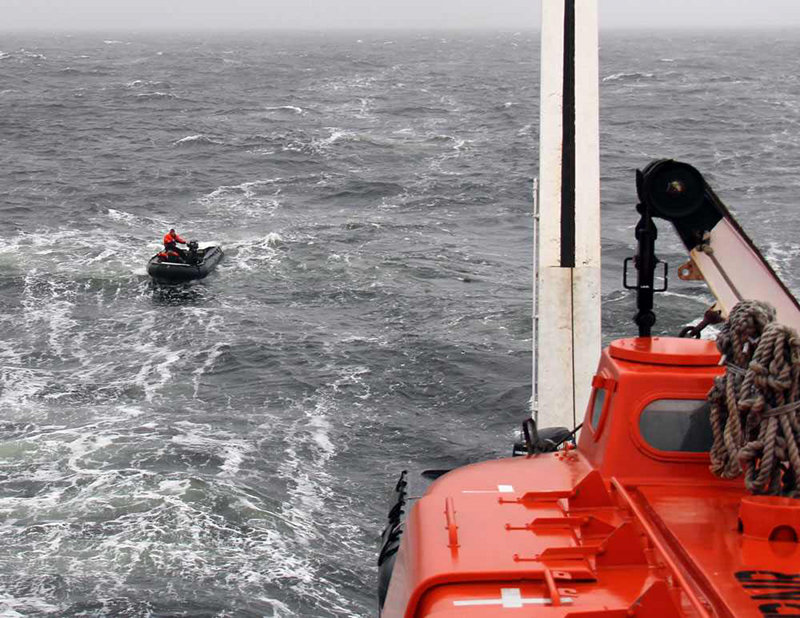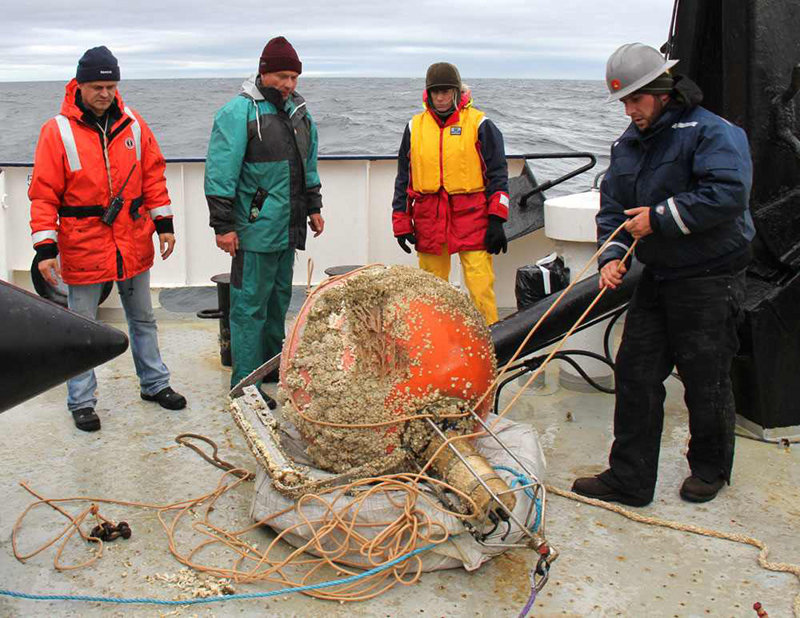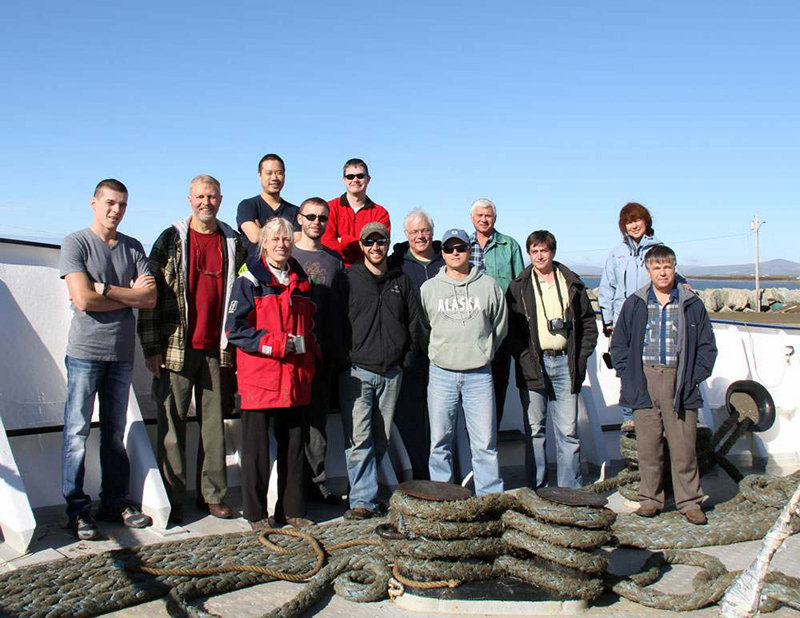
By Aleksey Ostrovskiy, Group Alliance, Russia, Russian Federation
September 1, 2012

The Zodiac trails the Khromov during round one of the Bering Strait rodeo. Image courtesy of Aleksey Ostrovskiy, 2012 RUSALCA Expedition, RAS-NOAA. Download larger version (jpg, 349 KB).
Just prior to the current leg of the Russian-American Long-term Census of the Arctic (RUSALCA) expedition, a small team of intrepid explorers headed over to the Russian side of Bering Strait to try to recover three oceanographic moorings that had been there for two years. Aleksey Ostrovskiy was on the cruise and describes the experience. The recovery of the three moorings in the western (Russian) part of the Bering Strait was, I believe, the most dramatic and exciting moment in the history of the RUSALCA project.
We had only one day – August 25, 2012 (with several extra hours in reserve) – for the whole operation, in which three moorings had to be recovered.
Such moorings are usually released from an anchor to surface by coded acoustic signals sent via hydrophone from the ship. If they don’t surface (usually because of marine organisms clogging the release systems) we have to drag for them. Dragging involves sending a long, heavy metal cable from a winch to the bottom of the ocean to try to hook the mooring or knock it loose. As the moorings had already been in the water for two years and it was likely that dragging was going to be the only way to get them, the recovery work had to be done in record time.
Leaving the herculean permissions paper work preparation coordinated by Vladimir Bakhmutov for another story, I shall shortly describe the day. We started with the first morning light (04:00 am). The weather was the chief concern (among many).
Weather is always a concern at sea, but in our case, we had no time to waste and were dreaming about low wind and waves. But that day, bad luck tried to test us with a severe storm. And, it was only one of many circumstances that were against us.

Jeff DiPietro waits to hook a mooring. Image courtesy of Aleksey Ostrovskiy, 2012 RUSALCA Expedition, RAS-NOAA. Download larger version (jpg, 384 KB).
For time economy we planned to use an inflatable boat (called a Zodiac) to catch and tow the moorings to the ship to hook them to the ship’s crane. Not fun in a big storm. Still, we lunched Zodiac with Nathan Russ, Stephen Egan, and Michael Kong inside. At mooring site number one, we sent an acoustic signal to check that the mooring was there (Kathy Crane volunteered to be an acoustic-emitter-get-in-and-out-of-the-water assistant). Mooring replied – good news! We sent a signal to the mooring with the command to drop the anchor and surface. Then we waited. All eyes were on the deck. Yells – “it surfaced!” The Zodiac headed to the object on the surface. They radioed back – “It is a dead walrus and not the mooring!” What a disappointment! One can only imagine the coincidence.
Dragging had to be undertaken for this mooring. The guys in Zodiac were already wet and exhausted and the small boat periodically disappeared in the waves, so we decided to bring them back aboard. With a lot of stress and risk, we pulled the small boat out of the stormy ocean by crane. Dragging started. It is like fishing – only with from a winch and steel cable. Soon the cable hit the mooring and it surfaced. This time it was the mooring, and not a walrus! But we had to catch it with the grapples, hooks, and ropes. And so the mooring rodeo began.
Capitan Alexander D’yachenko moved the vessel towards the mooring and Jeff Pietro got it on the hook with the pole. Yes! Soon the crane hauled mooring on board and we shook hands. We lead 1:0!

A barnacle-covered mooring on deck. Image courtesy of Aleksey Ostrovskiy, 2012 RUSALCA Expedition, RAS-NOAA. Download larger version (jpg, 420 KB).
The situation got worse at the site of the second mooring. Wind and waves got higher and, in addition to all that, the 25-year-old deck box that talks to the acoustic releases stopped functioning – there was the smell of burning transistors coming from the box. How to get two remaining moorings back?
There is only one option now - to drag for them and pull them out with the anchors attached. This is a very hard and risky process in a storm. So we stared dragging for mooring number two. Sergei Iarosh and Iurii Pashchenko operating the winch and the A-frame reported that they caught something heavy. But, after ten minutes, the catch fell off. For us it was a signal that the mooring was moved to the new unknown position and lost (bad news!). But then we saw the mooring flotation was hanging on the dragging hook (good news!).
Jeff was trying to get the mooring on the crane’s hook, but a wave kicked it back to the ocean (bad news!). The mooring was covered by barnacles and hard to see. The ship maneuvered towards the mooring, but the mooring disappeared in the waves and was lost to sight by everyone (bad news!). We thought it was gone forever. Then Chief Mate Aleksander Rykunov calculated where it might be, turned the ship there and found it! We approached the mooring with hooks and grapples.
Myself and Jonathan Whitefield were practicing to throw a new type of long distance A-frame lasso, but the mooring came close enough to use a grapple. Jonathan made three attempts and missed. I missed first and second time, but the third time hooked the mooring (good news!). I pulled it closer to the ship with Nathan and gave it to the crane hook team but the mooring got loose again and moved backwards along the hull. It was still right under us and at the very end of the ship when boatswain Vasily Naydenko dropped a metal wire loop on it. Than we struggled again to get the mooring on the crane’s hook.
Finally, the mooring was on the deck. The hook pole was broken and went to the bottom. Jeff’s hand was bleeding. That is what I call a Bering Strait rodeo! We lead 2:0. The usual flotation and instrument cleaning and data downloading procedures have begun for the recovered instruments involving the unusual team – Kathy (cleaning) and Jonathan (downloading). Michael Kong, Alexander Bosin, and Alexander Kolesnik were helping on the deck.

The "RUSALCA Wranglers" mooring recovery team. Image courtesy of Aleksey Ostrovskiy, 2012 RUSALCA Expedition, RAS-NOAA. Download larger version (jpg, 378 KB).
On the way to the mooring number three, bad luck surrendered and left us. Marshall Swartz repaired the deck box and we “talked” to the last mooring. It surfaced without having to be dragged and was caught by Jeff and the team with a hook attached to the “brand new” pole made of rusted water plumbing pipe. Soon after the third mooring got on deck the storm calmed down and the sun showed up…
The Bering Strait rodeo was over.